Abstract
OBJECTIVE: The purpose of this study was to evaluate the accuracy of abdominal ultrasonography (US) for screening and grading pediatric splenic injury. SUMMARY BACKGROUND DATA: The use of abdominal US has increased rapidly as a method of evaluating organ damage after blunt abdominal trauma. Despite US's increasing use, little is known about its accuracy in children with splenic injury. METHODS: Children (N = 32) suffering blunt abdominal trauma who were diagnosed with splenic injury by computerized tomography (CT) scan prospectively were enlisted in this study. Degree of splenic injury was evaluated by both CT and US. The ultrasounds were evaluated by an initial reading as well as by a radiologist who was blinded as to the results of the CT. RESULTS: Twelve (38%) of the 32 splenic injuries found on CT were missed completely on the initial reading of the US. When the ultrasounds were graded in a blinded fashion, 10 (31%) of the splenic lacerations were missed and 17 (53%) were downgraded. Seven (22%) of the 32 splenic fractures were not associated with any free intraperitoneal fluid on the CT scan. CONCLUSIONS: This study has shown that US has a low level of sensitivity (62% to 78%) in detecting splenic injury and downgrades the degree of injury in the majority of cases. Reliance on free intraperitoneal fluid may be inaccurate because not all patients with splenic injury have free intra-abdominal fluid. Based on these findings, US may be of limited use in the initial assessment, management, and follow-up of pediatric splenic trauma.
Full text
PDF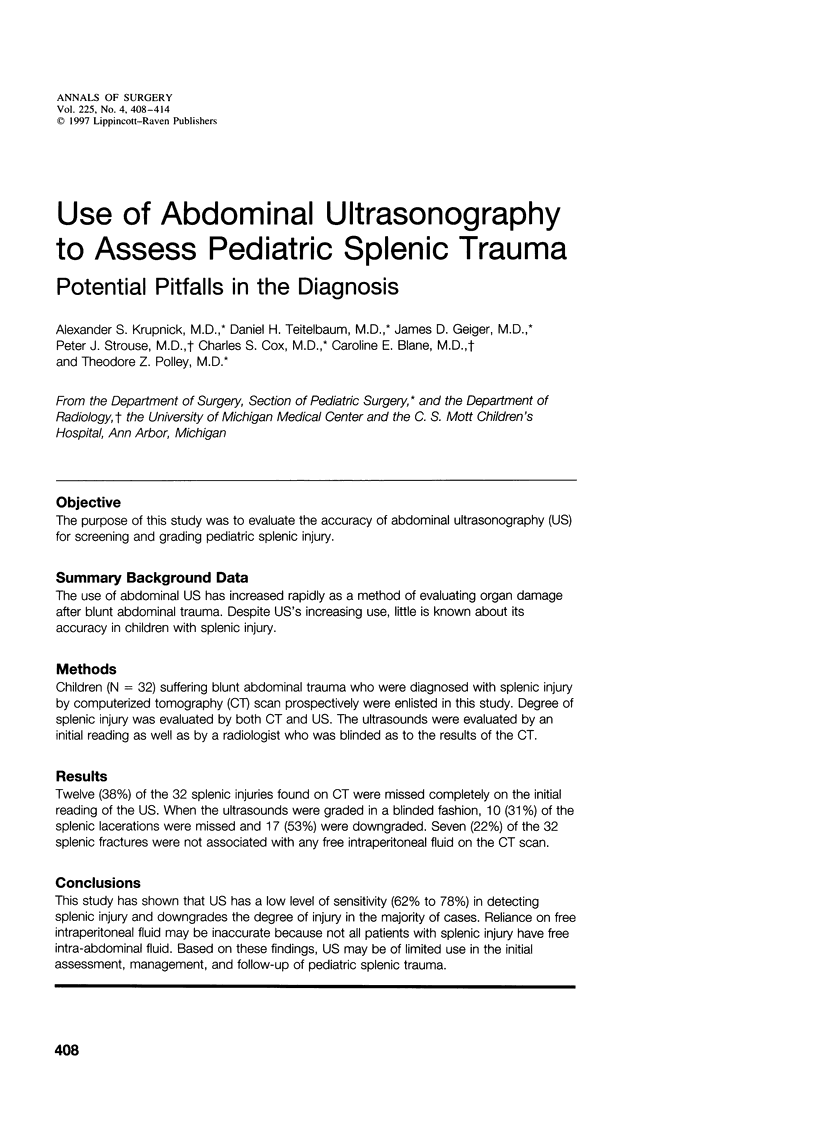
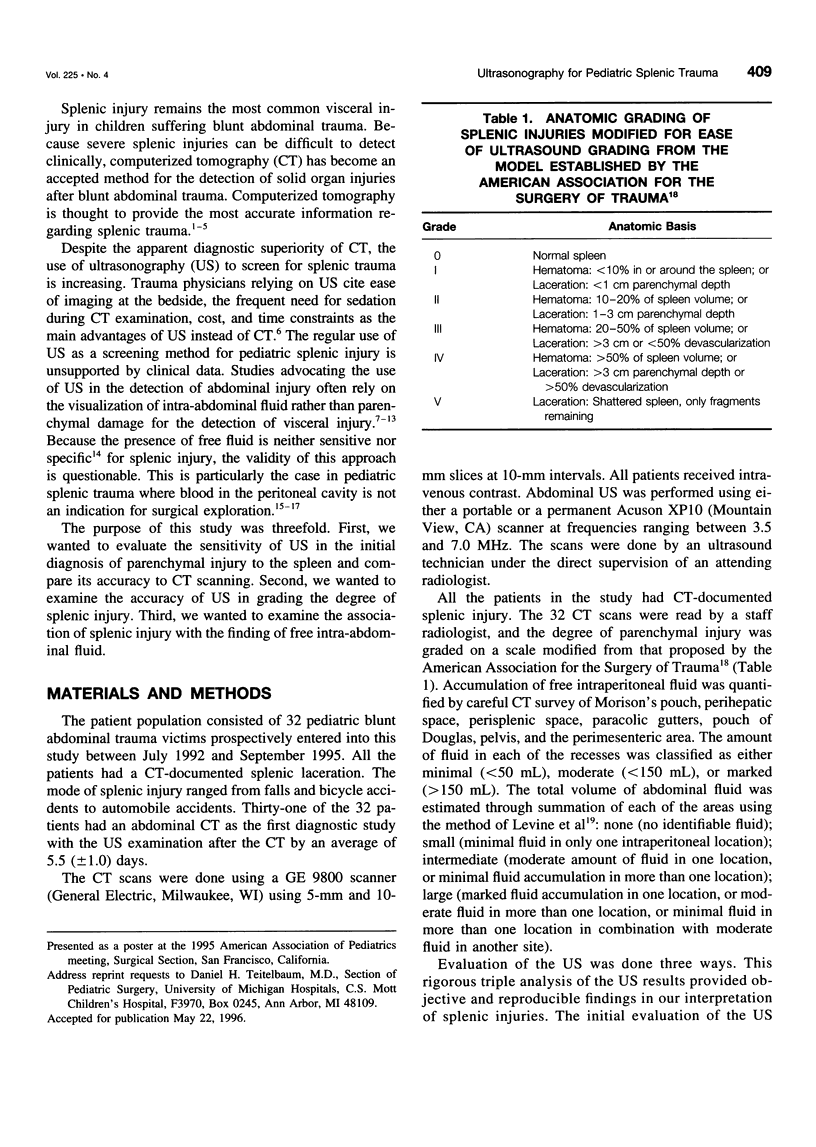
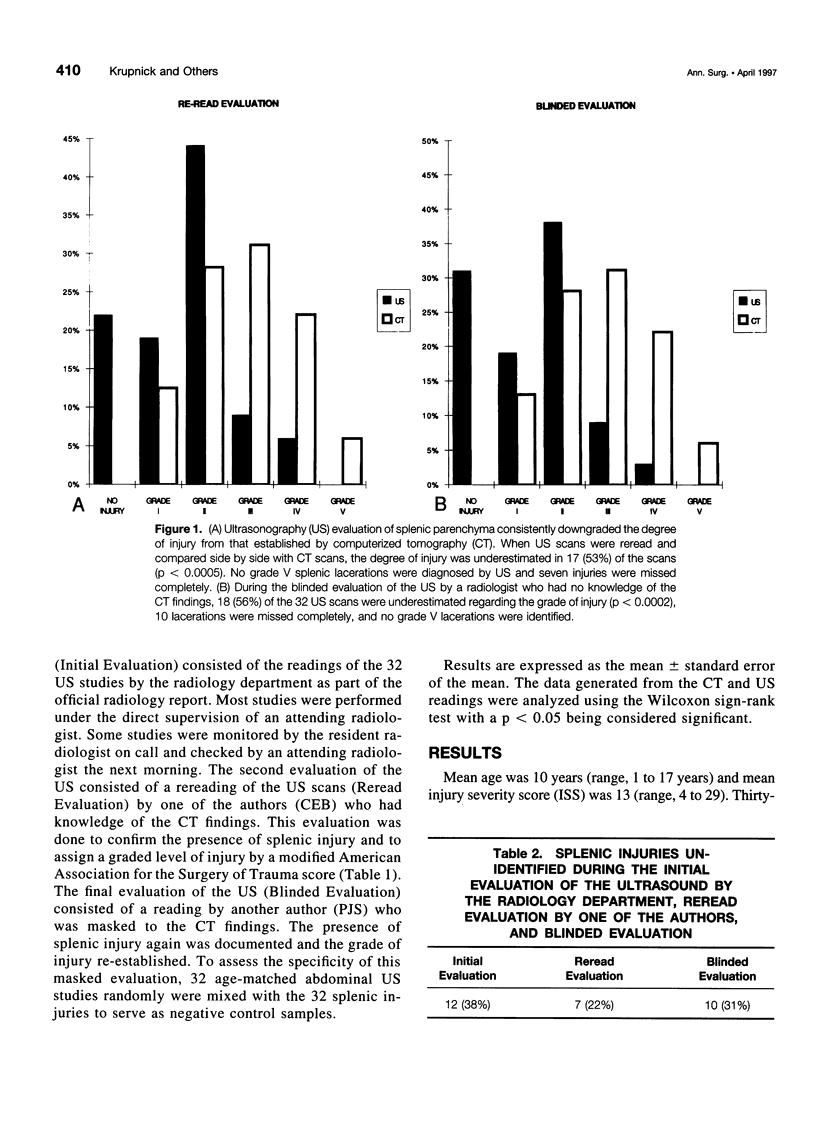
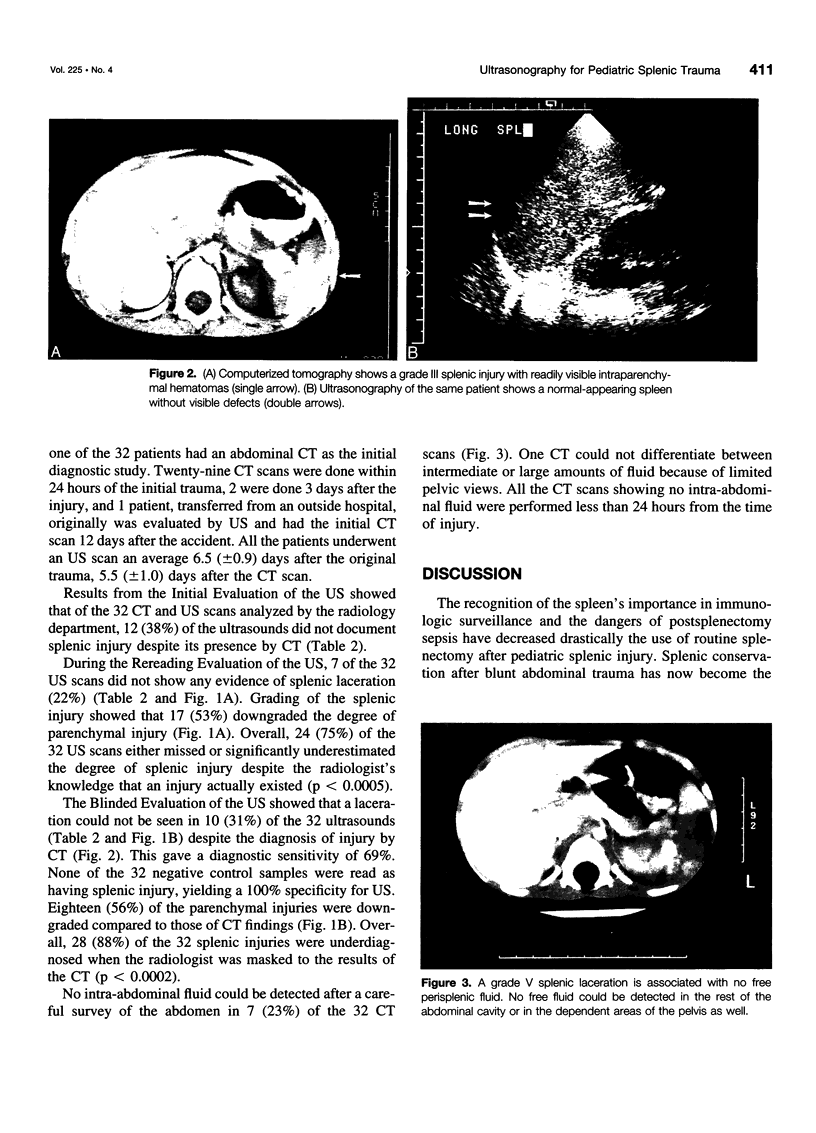
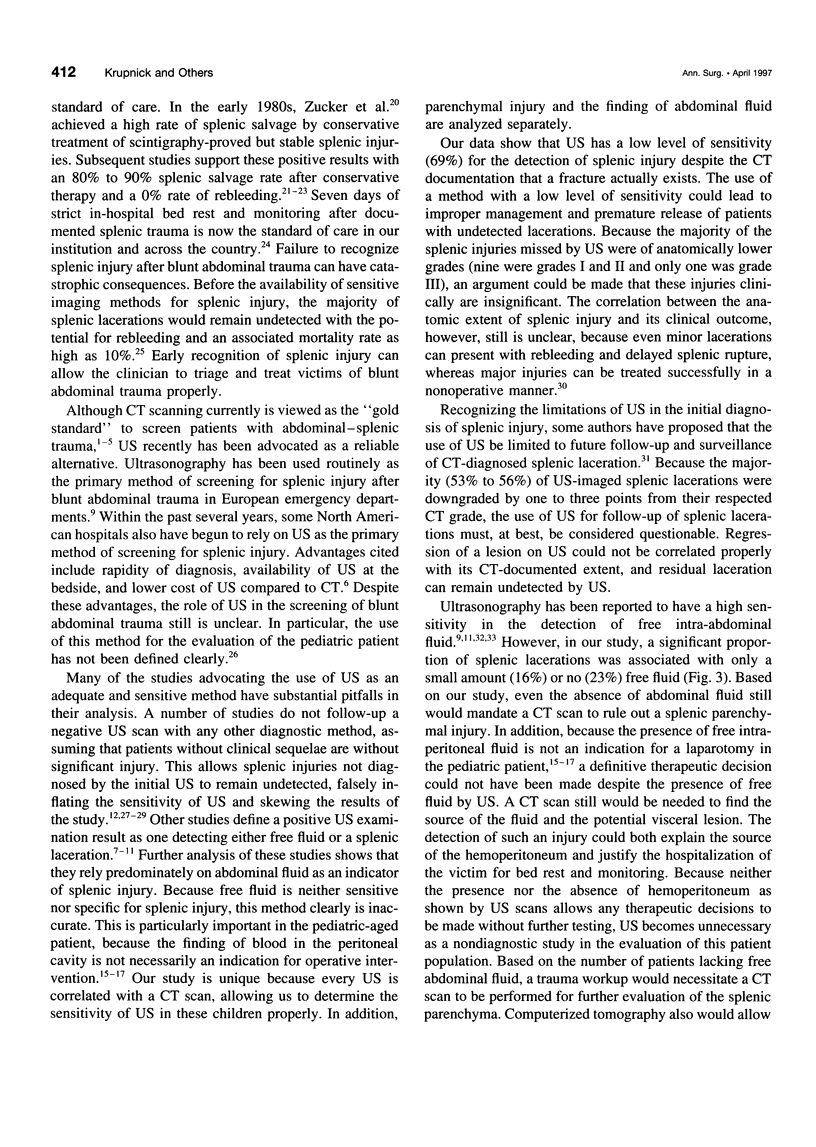
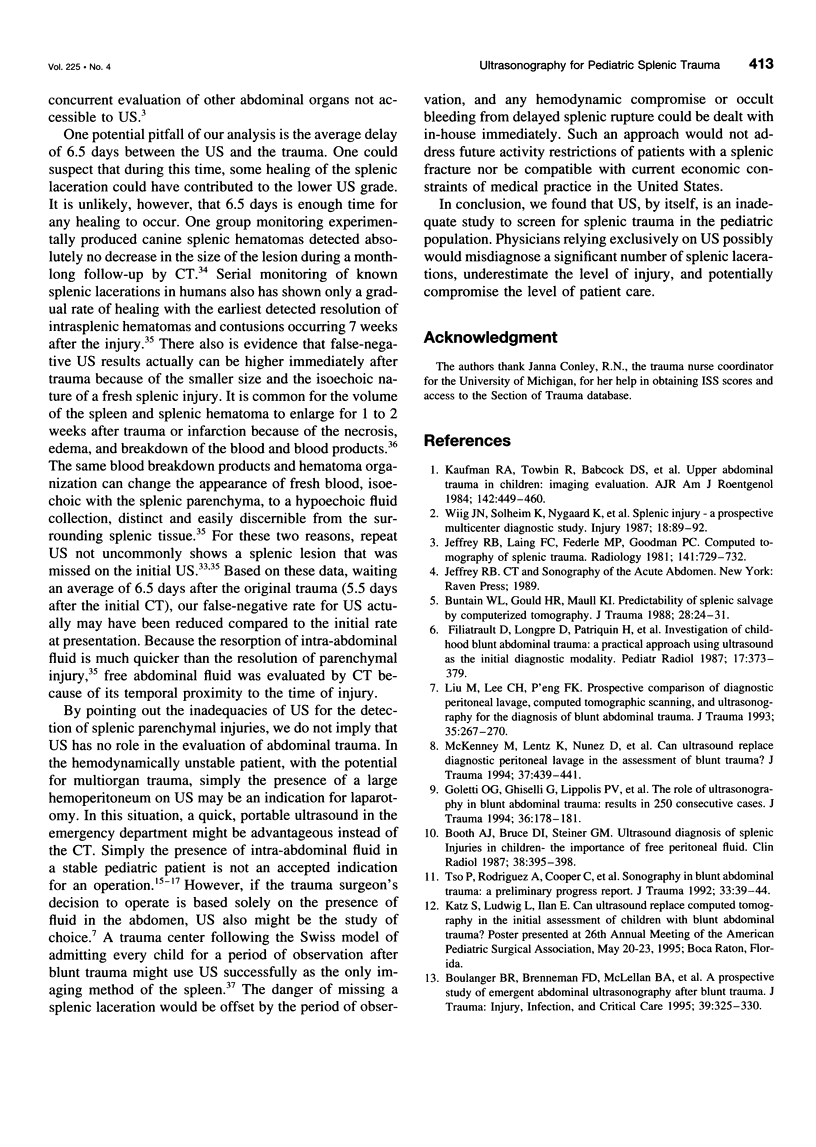
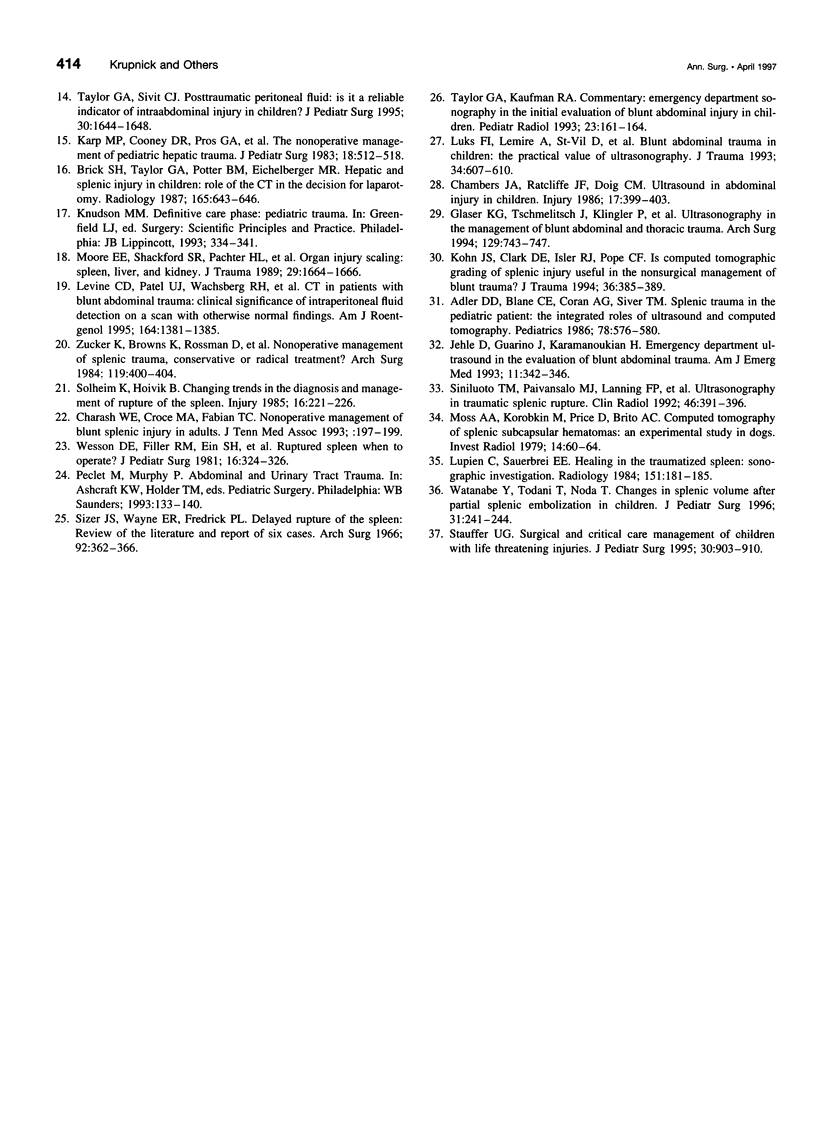
Images in this article
Selected References
These references are in PubMed. This may not be the complete list of references from this article.
- Adler D. D., Blane C. E., Coran A. G., Silver T. M. Splenic trauma in the pediatric patient: the integrated roles of ultrasound and computed tomography. Pediatrics. 1986 Oct;78(4):576–580. [PubMed] [Google Scholar]
- Booth A. J., Bruce D. I., Steiner G. M. Ultrasound diagnosis of splenic injuries in children--the importance of free peritoneal fluid. Clin Radiol. 1987 Jul;38(4):395–398. doi: 10.1016/s0009-9260(87)80235-0. [DOI] [PubMed] [Google Scholar]
- Boulanger B. R., Brenneman F. D., McLellan B. A., Rizoli S. B., Culhane J., Hamilton P. A prospective study of emergent abdominal sonography after blunt trauma. J Trauma. 1995 Aug;39(2):325–330. doi: 10.1097/00005373-199508000-00022. [DOI] [PubMed] [Google Scholar]
- Brick S. H., Taylor G. A., Potter B. M., Eichelberger M. R. Hepatic and splenic injury in children: role of CT in the decision for laparotomy. Radiology. 1987 Dec;165(3):643–646. doi: 10.1148/radiology.165.3.3685344. [DOI] [PubMed] [Google Scholar]
- Buntain W. L., Gould H. R., Maull K. I. Predictability of splenic salvage by computed tomography. J Trauma. 1988 Jan;28(1):24–34. doi: 10.1097/00005373-198801000-00004. [DOI] [PubMed] [Google Scholar]
- Chambers J. A., Ratcliffe J. F., Doig C. M. Ultrasound in abdominal injury in children. Injury. 1986 Nov;17(6):399–403. doi: 10.1016/0020-1383(86)90080-x. [DOI] [PubMed] [Google Scholar]
- Charash W. E., Croce M. A., Fabian T. C. Nonoperative management of blunt splenic injury in adults. J Tenn Med Assoc. 1993 May;86(5):197–199. [PubMed] [Google Scholar]
- Filiatrault D., Longpré D., Patriquin H., Perreault G., Grignon A., Pronovost J., Boisvert J. Investigation of childhood blunt abdominal trauma: a practical approach using ultrasound as the initial diagnostic modality. Pediatr Radiol. 1987;17(5):373–379. doi: 10.1007/BF02396611. [DOI] [PubMed] [Google Scholar]
- Glaser K., Tschmelitsch J., Klingler P., Wetscher G., Bodner E. Ultrasonography in the management of blunt abdominal and thoracic trauma. Arch Surg. 1994 Jul;129(7):743–747. doi: 10.1001/archsurg.1994.01420310075013. [DOI] [PubMed] [Google Scholar]
- Goletti O., Ghiselli G., Lippolis P. V., Chiarugi M., Braccini G., Macaluso C., Cavina E. The role of ultrasonography in blunt abdominal trauma: results in 250 consecutive cases. J Trauma. 1994 Feb;36(2):178–181. doi: 10.1097/00005373-199402000-00004. [DOI] [PubMed] [Google Scholar]
- Jeffrey R. B., Laing F. C., Federle M. P., Goodman P. C. Computed tomography of splenic trauma. Radiology. 1981 Dec;141(3):729–732. doi: 10.1148/radiology.141.3.7302229. [DOI] [PubMed] [Google Scholar]
- Jehle D., Guarino J., Karamanoukian H. Emergency department ultrasound in the evaluation of blunt abdominal trauma. Am J Emerg Med. 1993 Jul;11(4):342–346. doi: 10.1016/0735-6757(93)90164-7. [DOI] [PubMed] [Google Scholar]
- Karp M. P., Cooney D. R., Pros G. A., Newman B. M., Jewett T. C., Jr The nonoperative management of pediatric hepatic trauma. J Pediatr Surg. 1983 Aug;18(4):512–518. doi: 10.1016/s0022-3468(83)80211-5. [DOI] [PubMed] [Google Scholar]
- Kaufman R. A., Towbin R., Babcock D. S., Gelfand M. J., Guice K. S., Oldham K. T., Noseworthy J. Upper abdominal trauma in children: imaging evaluation. AJR Am J Roentgenol. 1984 Mar;142(3):449–460. doi: 10.2214/ajr.142.3.449. [DOI] [PubMed] [Google Scholar]
- Kohn J. S., Clark D. E., Isler R. J., Pope C. F. Is computed tomographic grading of splenic injury useful in the nonsurgical management of blunt trauma? J Trauma. 1994 Mar;36(3):385–390. doi: 10.1097/00005373-199403000-00018. [DOI] [PubMed] [Google Scholar]
- Levine C. D., Patel U. J., Wachsberg R. H., Simmons M. Z., Baker S. R., Cho K. C. CT in patients with blunt abdominal trauma: clinical significance of intraperitoneal fluid detected on a scan with otherwise normal findings. AJR Am J Roentgenol. 1995 Jun;164(6):1381–1385. doi: 10.2214/ajr.164.6.7754877. [DOI] [PubMed] [Google Scholar]
- Liu M., Lee C. H., P'eng F. K. Prospective comparison of diagnostic peritoneal lavage, computed tomographic scanning, and ultrasonography for the diagnosis of blunt abdominal trauma. J Trauma. 1993 Aug;35(2):267–270. doi: 10.1097/00005373-199308000-00016. [DOI] [PubMed] [Google Scholar]
- Luks F. I., Lemire A., St-Vil D., Di Lorenzo M., Filiatrault D., Ouimet A. Blunt abdominal trauma in children: the practical value of ultrasonography. J Trauma. 1993 May;34(5):607–611. doi: 10.1097/00005373-199305000-00001. [DOI] [PubMed] [Google Scholar]
- Lupien C., Sauerbrei E. E. Healing in the traumatized spleen: sonographic investigation. Radiology. 1984 Apr;151(1):181–185. doi: 10.1148/radiology.151.1.6701312. [DOI] [PubMed] [Google Scholar]
- McKenney M., Lentz K., Nunez D., Sosa J. L., Sleeman D., Axelrad A., Martin L., Kirton O., Oldham C. Can ultrasound replace diagnostic peritoneal lavage in the assessment of blunt trauma? J Trauma. 1994 Sep;37(3):439–441. doi: 10.1097/00005373-199409000-00018. [DOI] [PubMed] [Google Scholar]
- Moore E. E., Shackford S. R., Pachter H. L., McAninch J. W., Browner B. D., Champion H. R., Flint L. M., Gennarelli T. A., Malangoni M. A., Ramenofsky M. L. Organ injury scaling: spleen, liver, and kidney. J Trauma. 1989 Dec;29(12):1664–1666. [PubMed] [Google Scholar]
- Moss A. A., Korobkin M., Price D., Brito A. C. Computed tomography of splenic subcapsular hematomas: an experimental study in dogs. Invest Radiol. 1979 Jan-Feb;14(1):60–64. doi: 10.1097/00004424-197901000-00010. [DOI] [PubMed] [Google Scholar]
- Siniluoto T. M., Päivänsalo M. J., Lanning F. P., Typpö A. B., Lohela P. K., Kotaniemi A. E. Ultrasonography in traumatic splenic rupture. Clin Radiol. 1992 Dec;46(6):391–396. doi: 10.1016/s0009-9260(05)80685-3. [DOI] [PubMed] [Google Scholar]
- Sizer J. S., Wayne E. R., Frederick P. L. Delayed rupture of the spleen. Review of the literature and report of six cases. Arch Surg. 1966 Mar;92(3):362–366. doi: 10.1001/archsurg.1966.01320210042007. [DOI] [PubMed] [Google Scholar]
- Solheim K., Høivik B. Changing trends in the diagnosis and management of rupture of the spleen. Injury. 1985 Jan;16(4):221–226. doi: 10.1016/s0020-1383(85)80002-4. [DOI] [PubMed] [Google Scholar]
- Stauffer U. G. Surgical and critical care management of children with life-threatening injuries: the Swiss experience. J Pediatr Surg. 1995 Jul;30(7):903–910. doi: 10.1016/0022-3468(95)90311-9. [DOI] [PubMed] [Google Scholar]
- Taylor G. A., Kaufman R. A. Commentary: emergency department sonography in the initial evaluation of blunt abdominal injury in children. Pediatr Radiol. 1993;23(3):161–163. doi: 10.1007/BF02013820. [DOI] [PubMed] [Google Scholar]
- Taylor G. A., Sivit C. J. Posttraumatic peritoneal fluid: is it a reliable indicator of intraabdominal injury in children? J Pediatr Surg. 1995 Dec;30(12):1644–1648. doi: 10.1016/0022-3468(95)90442-5. [DOI] [PubMed] [Google Scholar]
- Tso P., Rodriguez A., Cooper C., Militello P., Mirvis S., Badellino M. M., Boulanger B. R., Foss F. A., Jr, Hinson D. M., Mighty H. E. Sonography in blunt abdominal trauma: a preliminary progress report. J Trauma. 1992 Jul;33(1):39–44. doi: 10.1097/00005373-199207000-00009. [DOI] [PubMed] [Google Scholar]
- Watanabe Y., Todani T., Noda T. Changes in splenic volume after partial splenic embolization in children. J Pediatr Surg. 1996 Feb;31(2):241–244. doi: 10.1016/s0022-3468(96)90006-8. [DOI] [PubMed] [Google Scholar]
- Wesson D. E., Filler R. M., Ein S. H., Shandling B., Simpson J. S., Stephens C. A. Ruptured spleen--when to operate? J Pediatr Surg. 1981 Jun;16(3):324–326. doi: 10.1016/s0022-3468(81)80689-6. [DOI] [PubMed] [Google Scholar]
- Wiig J. N., Solheim K., Nygaard K., Anda O., Runden T. O., Halvorsen J. F., Andenaes K., Dahl S., Danielsen S., Giercksky K. E. Splenic injury--a prospective multicentre diagnostic study. Injury. 1987 Mar;18(2):89–92. doi: 10.1016/0020-1383(87)90179-3. [DOI] [PubMed] [Google Scholar]
- Zucker K., Browns K., Rossman D., Hemingway D., Saik R. Nonoperative management of splenic trauma. Conservative or radical treatment? Arch Surg. 1984 Apr;119(4):400–404. doi: 10.1001/archsurg.1984.01390160036008. [DOI] [PubMed] [Google Scholar]




